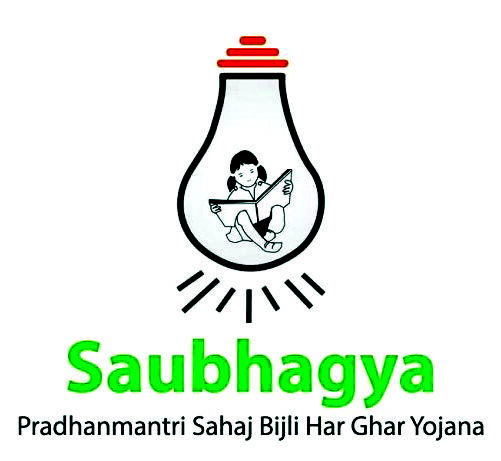The Pradhan Mantri Sahaj Bijli Har Ghar Yojana (Saubhagya) is a government initiative launched by Prime Minister Narendra Modi on September 25, 2017. The scheme aims to provide universal household electrification by ensuring electricity connections to all rural and urban households in India, especially targeting poor and underprivileged families.The Indian Government has launched Pradhan Mantri Sahaj Bijli Har Ghar Yojana – “Saubhagya” which aims to provide last mile electricity connections to all willing households in rural as well as urban areas. The scheme intends to achieve electrification programme to reach universal electrification as it facilitates sustainable economic and social growth in the country.

Salient Features of Saubhagya
- The beneficiary households for the free electricity access under this scheme would be identified using the Socio-Economic and Caste Census (SECC) database. However, un-electrified households that are not covered under the SECC database would also be provided with electricity connections under this scheme on the payment of Rs.500 which would be recovered by the DISCOMs in 10 instalments through the electricity bill.
- The electricity connections to un-electrified households would include the provision of the service line cable, energy meter including pre-paid or smart meter, single-point wiring. The LED lamps and associated accessories in line with the technical specifications and construction standard.
- In the case of un-electrified households that are located in the remote and inaccessible areas, the power loads of 200 to 300 Wp (with the battery bank) with the maximum number of 5 LED lights, 1 DC Fan, 1 DC power plug etc. would be given along with the terms of Repair and Maintenance (R&M) for the period of 5 years.
- The Saubhagya award scheme will also facilitate the power distribution firms (DISCOMs) and Power Department of the different States and their employees for achieving 100 per cent household electrification.
- All DISCOMs including the Private Sector DISCOMs, State Power Departments and RE Cooperative Societies would be eligible for the financial grant under the scheme in line with the Deen Dayal Upadhyaya Gram Jyoti Yojana (DDUGJY). Some eligible entities are to provide free electricity connections to the Below Poverty Line (BPL) households already sanctioned under the DDUGJY. In case of such entities are not able to find enough number of the BPL households in the project area, such households would not be considered for the funding of service connection cost under the Saubhagya scheme to avoid any possibility of duplication.
- The information of consumers viz, name and Aadhaar card number/contact number/bank account/driving license/voter identity etc., as available would be collected by the DISCOMs.
- The defaulters whose electricity connections have been disconnected would not be given any benefit under this scheme. However, the utilities would consider the settlement of old dues and reconnection as per the norms.
Funding Pattern
| Agency | Nature of support | Quantum of support | |
| Special Category States | Other than the Special Category States | ||
| Government of India | Grant | 85% | 60% |
| Utility/State Contribution | Own Fund | 5% | 10% |
| Loan (FIs/Banks) | Loan | 10% | 30% |
| Additional Grant from the GOI on the achievement of prescribed milestones | Grant | 50% of the total loan component (10%) that would be 5% | 50% of the total loan component (30%) that would be 15% |
| Maximum Grant by the GOI (including additional grant on the achievement of prescribed milestones) | Grant | 90% | 75% |
Objectives of Saubhagya Scheme
- Universal Electrification: Provide free electricity connections to all un-electrified households in rural and urban areas.
- Improve Quality of Life: Enable access to electricity for lighting, education, healthcare, and communication.
- Boost Socio-Economic Development: Encourage the use of electrical appliances, promoting economic growth and productivity.
- Reduce Dependence on Kerosene: Replace kerosene lamps with safer and cleaner electric lighting.
Documents Required
- Identity Proof: PAN, Aadhaar, Driving License, Voter Identity Card, etc.
- Address Proof: Aadhar card, legal Passport, Utility bill, Property tax bill, etc.
- Electricity Bill
- Below Poverty Line Certificate
- Any other documents (if applicable)
Application Procedure
The DISCOM in the area would organize camps in the villages or cluster of villages and prior detail about such camps would be widely published. The applicant needs to approach the DISCOM officials in the camp and must get the application form for the electricity connection that would be registered on spot. The electricity connection would be released by the DISCOM after the verification process, that would be mostly on spot. In the case, the applicants are not able to get details about the camp, one can also approach the nearest DISCOM office for the required guidance. On the other hand, the applicant will be requested to give their contact details to the concerned officials and after which the applicant will be contacted by the concerned agency. There is certain provision under the Saubhagya scheme to provide the last mile connectivity to the left out un-electrified households such as the erection of pole, conductor etc. and the electrical connection can be released to such households as per the scheme guidelines. On submission of the application for the electricity connection, the DISCOM officials would track/verify the site to find out additional electricity infrastructure required for the releasing electricity connection for such house.
FAQs
Achievements of the Saubhagya Scheme?
- As of March 31, 2019, over 2.82 crore households were electrified.
- Improved access to education, healthcare, and communication.
- Reduced usage of polluting fuels like kerosene.
- Enhanced rural productivity and quality of life.
Impact of Saubhagya Scheme?
- Enhanced rural electrification and reduced dependency on non-renewable sources.
- Boosted small businesses and self-employment in rural areas.
- Improved health outcomes by reducing indoor air pollution from kerosene usage.
- Bridged the urban-rural electrification gap significantly.